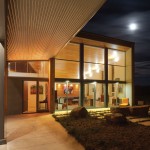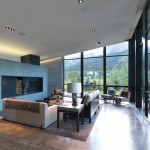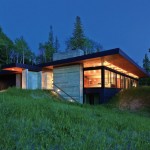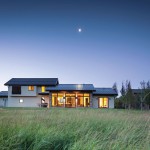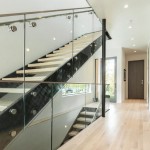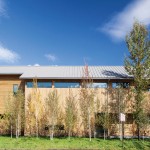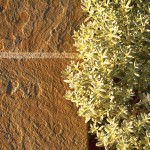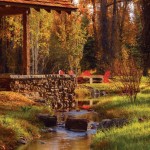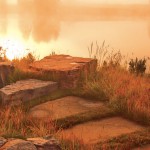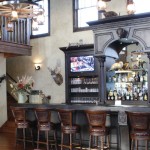WHEN TALENTED PROFESSIONALS TALK, WE LISTEN. WELCOME TO WESTERN HOME JOURNAL’S SHOPTALK
Admit it, you have an inquiring mind, and you want to know about the team building your dream home. We understand the inclination. So we decided to bring you ShopTalk, conversations with the talented pros designing, building, and outfitting your homes.
STEPHEN DYNIA
DYNIA ARCHITECTS DYNIA 
Architects is an architecture and planning firm with offices in Jackson Hole, Wyoming, and Denver, Colorado. Established in 1993, the firm’s goal is to provide innovative and sustainable design solutions combined with thorough, precise technical and administrative services.
Stephen Dynia, the managing principal, guides every project and has an unwavering commitment to the highest possible standards, as does the entire DYNIA team. With notable projects like Jackson Hole’s Performing Arts Pavilion and the upcoming Source Hotel in Denver, DYNIA Architects has been making the case for modern design across the West.
One of his earliest splashes in the Jackson area was “The Cubes,” three-story buildings with garden rooftops in East Jackson, informed by a modern vernacular that had yet to be introduced to the frontier of Jackson Hole. About moving West and finding a niche with contemporary design, founder, Stephen Dynia says, “After an early career with Skidmore, Owings and Merrill in New York designing international projects, I wanted to explore the interface of architecture and nature through the design of modern houses in a mountain environment. At that time, the mid ‘90s, no one was designing modern houses—Jackson Hole offered irresistible opportunity.”
In the isolation of Jackson, I have tried to have a meaningful influence on the perception of architecture through the buildings I design, seeing the environment as more of a frontier for new ideas than merely a place of pioneer fantasy—to create authentic architecture inspired by nature and community.
Do you have any special certifications or specialties?
Our key associates’ credentials include LEED AP and Certified Passive Home. I was elevated to the American Institute of Architects College of Fellows in the category of design in 2013. This distinction, granted to less than one percent of the 80,000+ membership, acknowledges career contributions to the built-environment through architecture.
What is your architectural and educational background?
I received my Bachelor of Arts and Architecture degrees from the Rhode Island School of Design. Studying architecture in an art school allowed me to focus on the creative potential of the discipline. We learned the beauty of making things.
When did you know that you wanted to be an architect and what motivated you?
At a young age I was intrigued with creating shelter—such as in the space under a table or an improvised clubhouse. In high school in the late 1960s I was in a program that held classes in an architect’s office, further fueling my interest. After high school and before RISD, I worked for an international firm in my neighborhood in New Haven, confirming my interest in formally studying architecture.
What do you consider the most exciting and inspiring developments in architecture throughout history?
The list is long! The theory of the primitive hut as the origin of shelter outside of a cave. The structural innovations of Gothic cathedrals—especially flying buttresses—allowing the architecture to reach to the sky. The Eiffel Tower as the first cultural symbol to embrace the Industrial Revolution, reviled at first, later embraced as a beloved icon of a great city. The honesty of early modern work (such as the dining pavilion of 1938 by Mies vander Rohe for the Resor family in Jackson Hole, sadly destroyed by a flood soon after its construction), and more recently, plasticity of form made possible through computer modeling.
Describe your process—how do you work with clients, contractors, and interior designers?
We listen to our clients to understand how they live, we analyze the site to understand all possibilities, and we collaborate to provide the best service, with the goal of creating living environments that exceed our client’s expectations.
What other specialties do you have in-house?
Designer cocktails!!!
Is there a local building you most admire?
The indigenous utilitarian buildings of this landscape and the memory of the Mies van der Rohe pavilion.
What do you listen to while you work?
Dave Brubeck or the voices in my head, whichever is loudest.
If you could own any three pieces of fine art, what would they be and why?
Pollack drip for the innovation of the relationship of paint and surface; Motherwell for strong positive figure and negative space; Rothko for the abstraction of landscape.
If you had just one wish today, what would it be?
Secular humanism as a path to world peace.
Favorite season? Why?
Four Seasons! The restaurant in the Seagram’s building more than the hotel, but the hotel is pretty good too.
What do you enjoy most about living and working where you do? Jackson Hole is a bit like a laboratory in that it is an island surrounded by nature, opposite of New York, with Central Park as nature surrounded by buildings.
Favorite architects?
Louis Kahn—his designs are timeless, the Salk Institute and Dacca. Eero Saarinen for diversity. Just look at Dulles Airport or MIT’s chapel. And Herzog & DeMeuron for designs like the deYoung Museum.
NEW WEST BUILDING COMPANY
ROBERT HUGGINS & JERRY DOUVILLE
Although a leader in the construction of modern homes, Jackson Hole-based New West Construction Company has completed multiple traditional homes over the years and is well versed in a variety of building styles. Their main concern, says co-founder Robert Huggins, “is making sure we do everything, no matter the style, to the highest standards.” But in as a matter of aesthetics, New West founders Huggins and Jerry Douville
have a genuine appreciation for contemporary architecture and design and are excited by the ever-increasing interest in that style in the West.
Another founding principle for New West is exceptional customer service. “Taking the best care of our clients is one of the cornerstones on which we’ve built our reputation,” says Huggins.
Both New West founders are avid recreationalists who love the active Jackson lifestyle and understand what it means to be a part of a small and tight-knit community. Douville says, “We are always honored when people choose New West to build their family home or their vacation home.
What we build becomes a part of the fabric of our special community and a sanctuary for our clients.” Having chosen to live and work in Jackson, both men understand the benefits of raising their families here and work hard to contribute to elevating the quality of life for their clients and their community.
“ WE ENJOY THAT WHAT WE CREATE
IS TANGIBLE AND BECOMES PART OF A NEIGHBORHOOD AND A COMMUNITY. WE WANT WHAT WE BUILD TO REFLECT WHO WE ARE AS PEOPLE: CREATIVE, PRACTICAL, EFFICIENT, PROGRESSIVE.”
-Robert Huggins and Jerry Douville, New West Construction Company
What is your professional background?
Jerry Douville: I started out building green houses and remodeling homes during high school summer vacations. After college, I moved West in search of job opportunities in the Mountain west and began working as a carpenter in the custom home field after moving to Jackson in 1995. I moved to California and gained more experience in the custom home market. In 2000, I decided to move back to Jackson to start New West.
Robert Huggins: I have been in the home building industry for 30+ years. I had an early start in the industry, at age 15, installing directional bootleg signs for new home communities, and worked my way up in the industry, gaining as much knowledge and expertise as I could. Over the years, and 10,000 single- and multi-family homes later, I have refined the process required to constantly succeed at increasing revenue flows, minimizing costs, boosting productivity, and meeting delivery goals.
How do you see construction changing in the next 5 to 10 years?
We look at this in two ways: the consumer market and sticks and bricks, and how both relate to our business strategy. The secondary home market has obviously recovered and we, like other general contractors, are benefitting from that. We have seen a lot of inflation in many areas, and believe this will continue in the coming years. However, as in other markets, we see it flattening out in the not too distant future. In addition, Jackson has a big shortage of skilled tradesmen and tradeswomen in many areas. In addition, energy efficiency is far more stringent than it has been in the past. Jackson, like many large cities, is getting greener. The consumer has become more environmentally conscious. We think that is good, and this is definitely the driver on how a house is designed and built these days.
What project(s) are you most excited about right now?
We have an amazing post and beam home in East Jackson that we started this spring. It’s traditional mountain architecture with the most current technology and efficiencies. The client is in our business, which makes it especially enjoyable, as he knows specifically what he wants and has a lot of good ideas to bring to the table from his experience doing large-scale projects on the East Coast.
What do you enjoy most about your work?
We enjoy that what we create is tangible and becomes part of a neighborhood and a community. We want what we build to reflect who we are as people: creative, practical, efficient, progressive. Ultimately we want the houses we build to become someone’s home that’s going to be lived in and enjoyed for many years.
Describe your process—how do you work with clients, designers, and architects?
Our clients range from investors to second homeowners to working families. Each set of clients has priorities and
all are very budget conscious these days. We need to be flexible with each and every client during every aspect of the building process. Whether we are contracted at the onset of a project, or after the architectural plans are completed, we like assisting on design, and making value-engineering recommendations to establish a realistic budget for our client. We have recently implemented client/builder software that streamlines our communications and allows our clients to be involved in the process in real time.
When did you know that you wanted to go into construction and what motivated you?
Robert: I grew up around the building industry. My high school best friend’s father owned a large development company. I had the fortunate opportunity to travel with them a lot. He would often unroll a set of architectural plans and look at
a document with a bunch of numbers on it. I later learned that document was just a project budget/job cost report. At 15 I thought to myself this would be such a fun job. 33 years later, I have never looked back.
AGROSTIS INC.
JASON SNIDER & HEATH KUSZAK
Agrostis, Inc. is a client-focused firm providing a full range of landscape architecture and land planning services to clients in the Jackson Hole area. Founded in 2008 by Heath Kuszak and Jason Snider, Agrostis has been built on its founders’ passion for landscape architecture and close and collaborative relationships with the best architects, design professionals, and contractors in the area. Kuszak and Snider agree that what makes their work so rewarding is “being able to work with the amazing clients we have met over the years.”
With a portfolio that tells many stories of exceptional projects, the partners at Agrostis are proud of the range of projects they’ve completed since 2008 and say that every project starts with an appreciation for each individual site.
What do you strive to create when you’re working on a project? What’s most important to you?
The most important thing we strive to do is meet our client’s goals. The design process is also very important to us. We learned long ago that while every project is different, we can apply a similar problem-solving process to each of them to successfully navigate each project’s unique challenges. It’s important to be able to develop a concept that we can easily communicate to a client; we use verbal, written, and graphic communication to ensure our clients have a thorough grasp of the concept. It’s important to us to make sure we are listening to our clients. Before we put pen to paper or a shovel in the ground, we need to understand why they want to be in Jackson, how they want to live inside and outside of their homes, and how they want to experience the landscape. Ultimately we hope that understanding will lead us to create something beautiful and inspiring for our clients.
What project (or projects) is most notable to you and your firm?
The Jensen Canyon Residence. The entire process—from our initial meeting with the clients and their family to seeing how they live in the home and interact with landscape—has been incredibly rewarding.
A well-designed residential landscape has to be…?
Functional and beautiful. It has to make its owners
want to go out and experience it—see it, touch it, breathe it in. It should make you want to live outside more.
Is your work easily recognizable, why or why not?
We never begin a new project with a preconceived notion about a particular design element or personal stamp that we need to see or want to put into the landscape. It’s really all about the client and helping them realize their vision for the project. Sometimes, the best design may be very traditional, representing a straightforward approach to the materials and their use. Other times we need to bring a fresh perspective to the use of materials to help our clients see how design problems can be solved in interesting ways.
“TOOLS OF INTELLECT HAVE GREATER IMPORTANCE FOR US THAN ANYTHING–CREATIVITY, COMMUNICATION SKILLS, AND A WILLINGNESS TO LEARN.”
-Heath Kuszak and Jason Snider, Agrostis, Inc.
Name three essential tools of the trade that you use to get your work done.
Tools of intellect have greater importance for us than anything—creativity, communication skills, and a willingness
to learn. Everyone uses computers and mobile devices nowadays to do their work so those go without saying. Other tools we continue to use are hand-drawn graphics—giving our clients the ability to visualize components of a design which may otherwise be difficult to understand in a 2D drawing; a creative approach to problem solving—allowing us to discover interesting alternatives for our clients whether they be small or large projects; and a willingness to adapt—understanding challenging field conditions and collaborating with contractors and other consultants to come up with the best solution. Our egos don’t stand in the way.
Do you work in a sustainable way?
We think so, and for a number of reasons. We work so much with native plants that we are often starting with a sustainable landscape. Everything requires some form of maintenance to thrive, so no project can just be installed, walked away from, and expected to successful. We also like to seek out hardscape and site furnishing materials available in our region and incorporate them as often as possible. To some extent, we try to be a sustainable force in our community by utilizing our client’s resources to employ and engage a wide range of skilled designers and tradesmen in and around our town. Finally, we
think our office and business model functions efficiently and sustainably. We are committed to staying small and
not burdening our clients with additional fees associated with multiple layers of management where ideas and communication often lose their way.
KODI FARNWORTH
ADVANCED IRRIGATION SOLUTIONS
From irrigation design and central control systems to water conservation strategies and water audits, Kodi Farnworth, president of Advanced Irrigation Solutions, says, “I’m really interested in working in water conservation. To date, I have saved over 70 million gallons per year on various landscape irrigation systems I have designed or adjusted.
My motivation is to save water by educating people in the irrigation industry about proper design, uniformity, matched precipitation, the use of the correct materials for the new installation, methods to remodel existing systems to cut there water use by 30 to 60 percent.” Farnworth’s AIS is experienced with large-scale commercial projects as well as residential projects.
What geographic area(s) do you serve?
Sun Valley, Twin Falls, Idaho Falls, Jackson. Eventually, everywhere!
What are some of your special qualifications?
I am a certified backflow tester and I’ve taken the certified landscape irrigation auditor class, and the certified irrigation contractor class, as well as courses in advanced irrigation design for water conservation. I’m a level 3 Maxicom Certified Central Control manager. I’m also currently working on my certified irrigation designer classes.
What inspired you to work towards water conservation?
About 10 years ago, I could see where the future of water was headed, and I understood we needed to change our approach. I decided to educate myself in water conservation and start a company that would help conserve water use in landscaping and agriculture while still keeping plants alive.
Who do you admire?
People who are willing to make a difference in water conservation.
What are some notable projects you have worked on?
Huntsman Springs in Jackson, The Lodges at Fish Creek in Jackson, and the Latter Day Saints Temple in Twin Falls.
What’s your process?
I meet with clients to determine their needs, and often meet with the landscape architect as well. I then determine the current state of the site. If it’s an existing system, I look at what it will take to correct the existing issues. I aim to cut the water use of each system by at least 50 percent. On a new site, I design the best system to water efficiently and pair that system with smart technology to manage the site.
Could you share a few projects with which you have had notable success?
I recently designed a system for a property in Sun Valley that now uses 70 percent less water than houses of the same size with comparable lots. I’ve outfitted Sun Valley’s Blaine County School District with central control and water management tools and by doing so, reduced the water usage by 50,000,000 gallons a year.
What is the difference between a good irrigation system and a bad one?
A good (or great!) water system can be achieved for less than 10 percent more than the cost of a traditional water system. In addition, a good water system uses 40 to 60 percent less water than a traditional system, both conserving water and saving considerable money on water bills.
What do you enjoy doing when you are not working on ways to conserve water?
Riding my horse and just being at peace in the mountains.
What is a book you would recommend?
Cadillac Desert—to get a solid understanding of our water issues in the West.
DRUMMOND AYERS & CREW
AUDIO VIDEO SPECIALISTS
The pros at Audio Video Specialists serve the Jackson Hole area and have extensive experience with home automation. Each AVS team member comes from a background in electronics and brings a commitment to quality to each project.
From dedicated studio-quality home theaters to the complete automated control of a house, AVS can upgrade your home or help advise you on integrating the right systems before you build. AVS takes pride in offering fair prices, professional installation, and most importantly, servicing the system for years after the original installation.
Founder Drummond Ayers says, “It is our priority that our clients are more than satisfied with the work we do and that our clients find the systems that we install easy to use. We design and install for the way our clients use the equipment; that approach ensures that our clients use technology they have invested in.”
“WITH THE INCREASINGLY SOPHISTICATED TECHNOLOGIES HITTING THE MARKET, WE ARE ALWAYS SEEING THE NEED FOR HIGHLY TRAINED TECHNICIANS WHO STAY UPDATED ON THE LATEST TECHNOLOGY, PRACTICES, AND PRODUCTS.”
-Drummond Ayers, Audio Visual Specialists
What services do you offer?
We work with smart-home integration, home theaters, whole-house audio, window treatments, system design, programming, and pre-wiring, home networking, support and maintenance, upgrades, calibration, panelized lighting
and retrofit lighting integration, retail sales, cameras, and so much more.
Do you have any special certifications or specialties?
We have Level 1 and Level 2 Control4 certified programmers on staff. We also have Control4 panelized lighting certified
staff members and a Crestron Digital Media designer, technician, and engineer on staff. Our staff is highly trained to work with all of our product lines.
How do you see your field changing in the next 5 to 10 years?
We have seen so much change around technology in the home over the past decade and more is certainly to come. We are seeing more attention to home automation, more “Do-It-Yourself” products, and with the increasingly sophisticated technologies hitting the market, we are always seeing the need for highly trained technicians who stay updated on the latest technology, practices, and products.
What project(s) are you most excited about right now?
We recently finished a high-end Control4 system that has full integration with the home. The Control4 touch panels offer integration with most subsystems through iPads and iPhones and offer full system control from one application. It’s a prime example of how smart home technology can make life simpler. Integration includes distributed audio and video, Lutron window treatments, Pentair Hot Tub, panelized lighting, heating, venting and cooling, and Honeywell security. Remotes access all of these systems from up to 100 smart devices.
What other specialties do you have in-house?
We also handle patching and painting of drywall and post-installation carpentry. We have skilled photographers, IT personnel, and networking professionals who deal with large systems.
Do you have favorite products you are known for?
We are proud of all of our lines, and we are proud to work with Control4 Home Automation, Sony XBR 4K Ultra HD televisions, and Wolf and JVC Pro 4K Ultra HD Home theater projectors.
What tricks of the trade have you learned over the years that you’d be willing to share with us?
A bigger company is not always a better one. In our field, it’s not the company with the most trucks and employees that is
the most successful. We have intentionally kept our team small and efficient. Each of our team members understands the importance of taking care of every client and being responsive to each client’s needs and the particularities of each project. Because we are committed to client satisfaction, client feedback always focuses on our thoroughness and how we have impeccable attention to detail.
What is the most exciting new product or development in your field?
We are pretty excited about the 4K/Ultra HDTV, the new surround-sound field Dolby Atmos, the fully connected home, and reasonably priced video distribution where all video sources can be centrally located and distributed to every television in the home.

